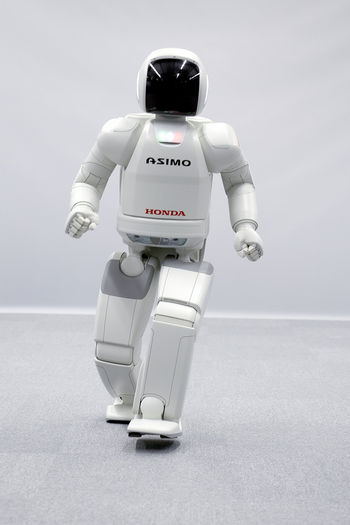ASIMO
ASIMO (アシモ ashimo) is the world's most advanced humanoid robot, developed by the Japanese company Honda. The first ASIMO was completed after 15 years of research, and it was officially unveiled on October 31, 2000. The robot resembles a small astronaut wearing a backpack, and is capable of performing a variety of tasks, including running, dribbling a ball, walking up and down stairs, and recognizing people by their appearance and voice. The name is short for "Advanced Step in Innovative MObility" and is also known as an abbreviation of ashita no mobility, meaning 'mobility in the future.'[1] It was named in reference to Isaac Asimov, an American professor and science fiction writer who is credited with coining the term robotics and proposing the Three Laws of Robotics.
Design concept
"Following in the steps of Honda motorcycles, cars and power products. Honda has taken up a new challenge in mobility - the development of a two-legged humanoid robot that can walk."[2]
Bipedal movement has been the primary focus of Honda's humanoid robotic research to create general-purpose, intelligent robots that can "coexist and cooperate with humans",[3] since it began in 1986 with the development of the 'E0' prototype. While there existed many different visions of futuristic robots, such as R2-D2 and C-3PO from Star Wars, it was recognized that human-like robots with bipedal mobility are the most ideal for operating and interacting with humans in human surroundings.
For example, a humanoid robot designed to move on wheels would not be able to use the stairs or move over tangles of wire.
For that reason, ASIMO's design is based on human appearance both function and proportion-wise, consisting of clearly discernible parts such as the head, torso, arms, hands, legs, and feet. In terms of size it
is an essential feature for as there may be obstacles and situations for which bipedal movement would be ideal. (
in human surroundings , beginning with E0 is an essential feature for a general-purpose robot that can operate in human surroundings
Honda humanoid robotic research
recognized that bipedal mobility was an essential feature for a
The challenge was undertaken to realize the goal of
Honda's humanoid robotic research began in 1986 with the vision to create general-purpose robots that can "coexist and cooperate with humans."
when it built a basic walking robot called 'E0' ASIMO is a humanoid robot designed with bipedal movement and other human-oriented features that are ideal for operating in human surroundings. Its humanoid body resembling an astronaut suit allows ASIMO to interact with human beings by making gestures and communicating face-to-face.
is a humanoid robot designed to move on foot, as it would need to
ASIMO is human-friendly
It is important to note that the current ASIMO is an experimental technology demonstrator that needs to undergo further development until it can be engaged in tasks such as reception work (currently possible) and elderly care assistance.
, currently involving
as an experimental platform
operating effectively in spaces shared with humans
a future robot
can simulate sophisticated and perform other tasks in controlled environments.
shown A humanoid robot is made to humanoid robotic research began in 1986 with the vision of producing robot that
ASIMO comprises a niche of
The aim of Honda's project with ASIMO is to
ASIMO's design engages the issue of dailythe its concept as a humanoid robot that operates within society as a companion or an assistant through .
in the manner of contains the challenge in it would serve in the capacity of . Its child-like size people-friendliness Honda's humanoid robotic research has evolved over the years to create a humanoid robot that is small and friendly to hu
Technology
Development history
notes
- ↑ Hirose, Masato, and Kenichi Ogawa, 2006. pp. 14
- ↑ "ASIMO Technology." Honda Worldwide. Honda Motor Co.,Ltd. Web. 24 Aug. 2011. <http://world.honda.com/ASIMO/technology/>.
- ↑ Pfeiffer, Friedrich, and Hirochika Inoue, 2007. pp. 5
